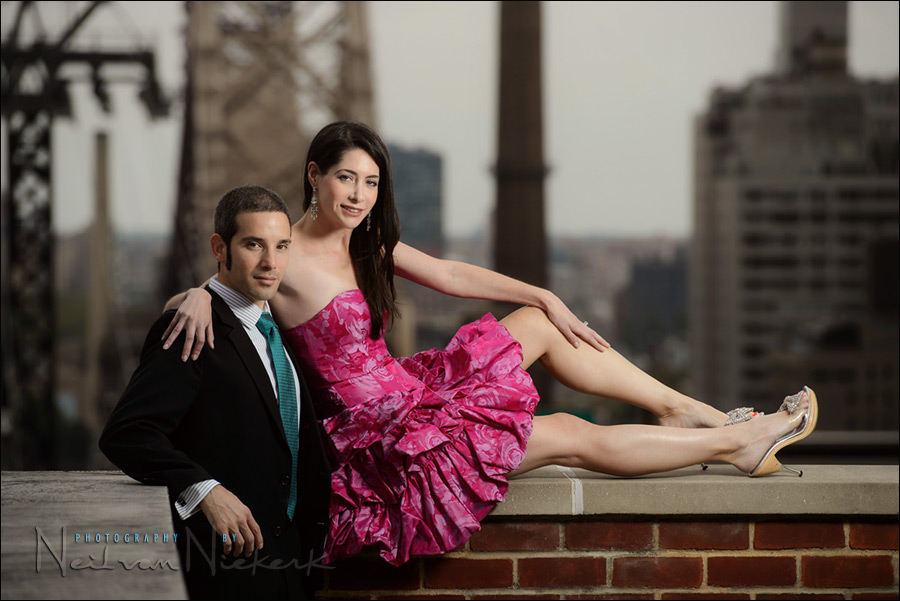
Softboxes with speedlights for on-location lighting
Off-camera flash is the easiest way to create dynamic lighting – and using a speedlight with a softbox, is on-location lighting at its most elegantly simple. For most of my on-location portraits, I like to travel (fairly) light, and my lighting of choice is a speedlight, wireless transmitters and a softbox. The softbox is either held up by a light-stand (which I weight down with my camera bag), or held up by an assistant (with the softbox on a monopod.)
I like TTL flash – it often gets us there faster than manual flash. But for consistency, especially when photographing someone in a static position relative to the light, manual flash is the only way to go.
I discussed beforehand with Allison and Scott the idea and feel for this photo session – glamorous. Night on the town kinda glamorous. For this New York rooftop location and that dress, a vertical photo would’ve have made less sense. Too much would be “lost” against the drab brick wall as background.
The pose was a compromise between something sexy & glamorous, and the practical need to have Allison not feel precarious on the (wide) ledge there. Scott had his arm around her, and I then asked Allison to drape an arm over Scott’s shoulder. In this way the pose came out of the environment and backdrop.
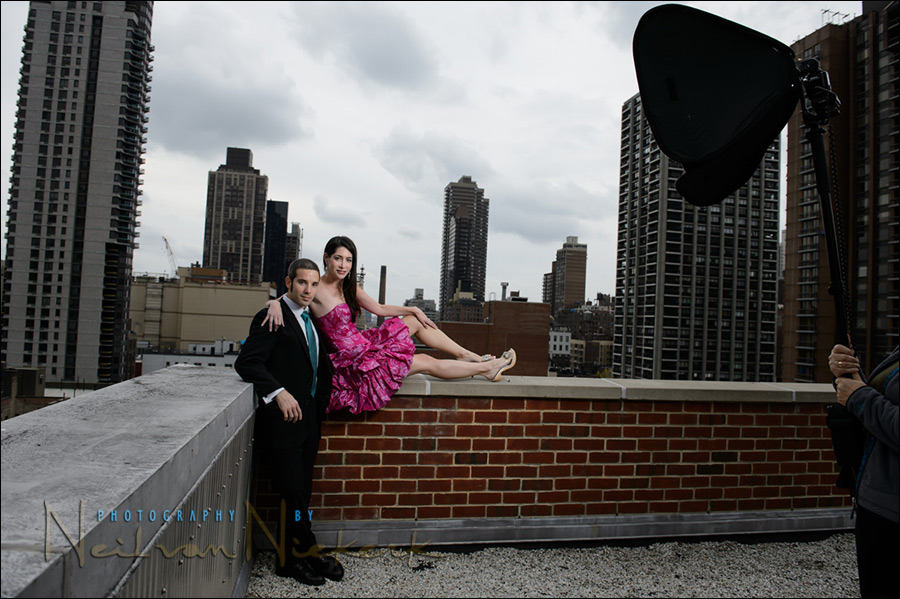
The pullback shot to show the positioning of the softbox – handheld by an assistant. The speedlight was set to manual output.
Camera settings and photo gear (or equivalents) used for the main image
- 1/250 @ f/5.6 @ 100 ISO
- Nikon D4
- Nikon 70-200mm f2.8 AF-S VR II /equivalent Canon EF 70-200mm f/2.8L IS II
- Nikon SB-910 Speedlight controlled by PocketWizard FlexTT5 Transceiver & AC3 Controller
or alternately, the Canon 600EX-RT Speedlite controlled by Canon ST-E3 Transmitter - Lastolite EZYBOX 24×24″ softbox (B&H / Amazon)

To show the progression, here is the photo without the additional light. My basic exposure was chosen so that the background wouldn’t blow out in over-exposure. Then the flash was added. At this distance and aperture, and using the softbox (which cuts down on the flash’s light), we were close to full manual output on the flash. But this is where I decided I want to be in terms of balancing them with the background.
Summary
This simple lighting setup works for so many on-location portraits, and is most often my starting point. It just works.
Related articles
- Off-camera flash vs. available light
- video clip: using the Canon 600EX-RT Speedlites on a photo shoot
- Off-camera flash: rim-lighting and using flare
- Gear updated: Flash photography workshops
- More reviews of lighting gear
- More articles about Off-Camera Flash
Recommended softboxes for speedlights
Lastolite EZYBOX 24×24″ softbox
The main advantage of this type of softbox, is how it folds open, and clips onto a “lollipop”. None of the metal rods that need to be mounted onto a speeding.
The Lastolite EZYBOX collapses into a conveniently small size … although the latest versions of this has a large triangular bag, instead of the smaller round bag. Still, it’s a handy softbox for speedlights, and very easy to setup. It has an inner baffle that can be removed if you need a bit more power from your flash.
Review: Lastolite Ezybox 24×24 softbox
To purchase:
Lastolite EZYBOX 24×24″ softbox (B&H / Amazon)
It also comes in a slightly larger version,
Lastolite EZYBOX 30×30″ softbox (B&H / Amazon)
Impact Quickbox 24×24″ softbox
Impact rebranded the Lastolite EZYBOX under their own name-brand. Slightly cheaper, but otherwise exactly the same as the Lastolite version. The same advantages and ease of setting up.
Review: Impact Quikbox Softbox (24″ x 24″)
To purchase:
Impact Quickbox 24×24″ softbox (B&H / Amazon)
Westcott Rapidbox 26″ Octa Softbox
The Westcott Rapidbox 26″ Octa Softbox is compact when it folds up, and comes in a handy carry bag. The carry bag has enough space for a speedlight and your favorite set of wireless triggers.
It is also easy to set up, with no rods and speed-ring like traditional softboxes. It folds open like an umbrella. Since the speedlight sits on the outside, it is easy to adjust as you need.
Review: Westcott Rapid Box 26″ Octa Softbox
To purchase:
Westcott Rapidbox 26″ Octabox (B&H / Amazon)
Profoto RFi Speedring for dual speedlights
The Profoto dual-flash Speedring is rugged (which means it is heavy), and it easily allows two speedlights! Double the power.
You can now add any softbox via the rods that go into the speed-ring. I use the medium-sized Profoto 1.3′ x 2′ softbox (affiliate) with these.
I use these in my flash photography workshops, because I can now accommodate different systems with one softbox. The two speedlights could be of different size and use different radio systems.
With two sets of these dual-flash speedrings, it means that we can accommodate up to 4 different flash systems simultaneously at the flash photography workshops!
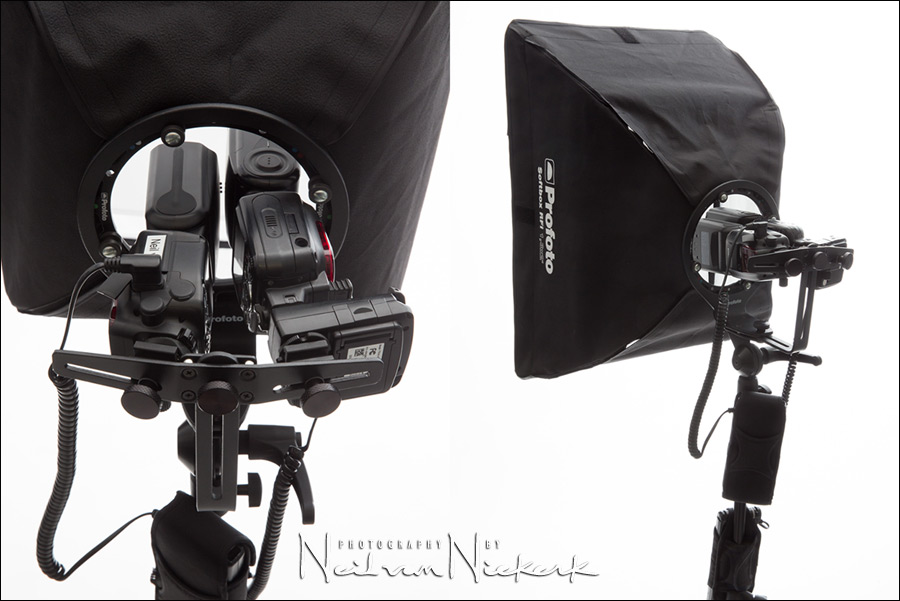
Review: Profoto RFi dual-flash speedring
To purchase:
Profoto RFi Dual Speedring (B&H / Amazon)
Profoto 1.3″ x 2″ softbox (B&H / Amazon)
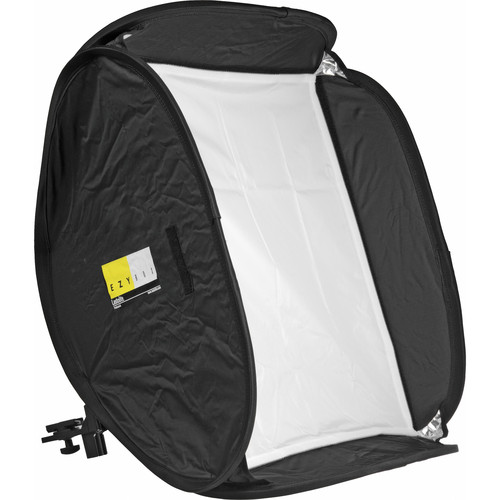
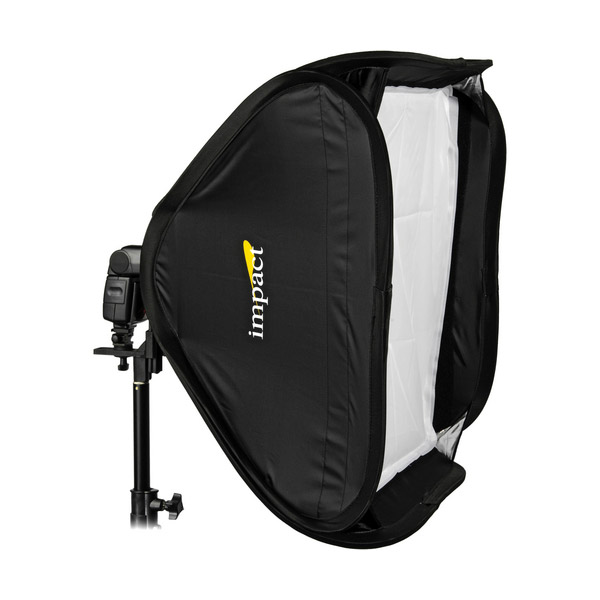

Everytime I get into your website for information I can’t get up from my computer. Really, Really great information. I am new at this so please be with me. I am looking to purchase a Softbox maybe a 30×40 inches or so. I know from the link posted by Drew that I need the Softbox, Speedring, lightstand and my Speedlight SB-600. Now, I see on your photo, that you have sometipe of Slave? I was plannng to buy the SU-800 and another SB-600 or use the one I have for the mean time. But Iknow there also cables and slaves that could be less expensive. Can you be so kind and and tell me what type of cable TTL can I use with my SB-600 and my Nikon D60. Its kind of confusing….to say the least.
Thank you
Antonio
Neil, through my readings I found out that some photographers say that the Sb-600 lacks the power to be use with Softboxes? Is this size limited? I though that maybe with a 24×24 softbox will work fine.
Antonio
Antonio, you could use the Nikon SU-800 (B&H), but that does bring in a limitation in how you position yourself in relation to the receiver. You need to stay more or less line-of-sight.
Honestly, I wouldn’t buy another SB-600 .. but rather a more powerful flashgun. If you are going to use it as an on-camera flash, then the SB-900 makes most sense. If you’re only going to use it as an off-camera manual flash, then an older speedlight like the SB-25 would be cheaper alternative.
At some point in the future you are going to need a wireless transmitter / receiver set. Right now however, there are more choices than before, and the decision less clear .. whether to go with the older PocketWizards or the newer generation of PocketWizards, or RadioPoppers .. or just the wireless TTL flash controllers made by the camera manufacturers.
The simplest option would be the older PocketWizards. They are reliable and just work.
Hi Neil,
I really like your softbox setup and am currently gathering bits and pieces to make something similar myself. There’s just one thing that interests me: How do you transport your gear? Disassembly of the softbox seems easy enough, but you still need some case for it.
Thanks,
Tobi
Tobi … I keep my lighting gear in a Tamrac roller case which is tall enough to hold umbrellas and light-stands.
I keep the speedlight softbox in its own carry bag.
Hi Neil,
What is the differance between a soft box and shooting through an umbrella ? Is it only light spilover ?
thanks
Derek
Derek .. it mostly has to do with how well you can contain the light from your flash. With an umbrella there is more spill on the background and areas surrounding the umbrella and flash.
Hi Neil or anyone else,
Just wanted to clarify as I’ve been a bit confused. For my benefit and others on the forum, here’s my understanding.
A.) To use a off-camera flash in manual mode.
1.) one could buy older flashes (like SB25..for $75 on EBay) or newer flashes (like SB900 which retail for $450)
2.) use older versions (or newer) versions of Pocket Wizards
B.) To use off-camera flash in TTL mode;
1.) one would need to use newer flashes (like SB900). Older flashes like SB25 won’t work in TTL mode.
AND
2.) one could use a sync cord such as SC28 or 29 (but one has the inconvenience of being tethered…running the risk of knocking over flashes, lightstands etc.)
or
3.) one could buy an Infra-red flash controller such as the SU-800.
Just curious, couldn’t the camera (such as D300) just act as the controller for an SB900 flash on a lightstand? Why would one need to purchase the SU800 for $250.
or
3.) one needs to use the latest Pocket Wizards or Radio Poppers that support TTL (however, I’ve read teething problems with the latest PW’s that are supposed to do this). This would be the way to go if/when the TTL capability is reliable, right?
The older versions of PW’s are reliable but won’t provide TTL metering so the flash would only work in manual mode. Right?
Hope above is correct. Please someone correct me if I am misunderstanding this.
Thanks
Ernst
is limited to a sync cord like SC28 or 29
Cheaper option for you to have powerful flashes and latest technology is to go with TTL Yongnuo flashes (~$100-120) and to get radio triggers like Yongnuo 622N TX and 622N(~$80 for a pair). Believe me these are pretty good.
I am using the 622N and TX for more than a year and these are extremely reliable and durable (light stand fell on hard ground exactly on the triggers at least thrice).
That’s just my two cents.
I’ve been using Yongnuo flashes – 560/560II/568EX (TTL for Nikon) along with the older RF602 triggers for a number of years. Sure, once in awhile they don’t fire, but overall they are fairly reliable. And if one falls and breaks it’s not a big loss. I use them in umbrellas and a 24×24 CheetahStand softbox and double them up in the Westcott Apollo Orb Octobox. I can’t imagine dropping the money for name brand flashes.
Ernst, you’ve nailed it there. You really have that many options to choose from.
These are good days to be a photographer! So many toys.
Hi Neil
Thank you for this post. My questions is related to larger group photos taken in the evening. What size softbox would you recommend? maybe even 2?
For larger group shots, I’d prefer to use 60″ umbrellas, and usually two of them.
However, two medium sized softboxes would do the trick as well. But umbrellas would be easier to set up.
Hey Neil
One question about your choice of using softboxes during an outdoor session, how do they react during wind gusts? Are they steadier then using umbrellas instead, or do you always add some weight to your stand?
Jan
The softboxes react well. It’s my poor assistant who holds the softbox up on a monopod who suffers. ; )
Seriously though, I’ve had the Lastolite EZYBOX come off with a gust of wind.
hi Neil
I am reading through all your posts here and have ordered your book which i cant wait to get into, my question is the setups you use look great and id love to buy everything youve mentioned so far but i didnt want to spend $300-400 on my first softbox setup, i guess my question is the local camera house here has a small softbox setup with stand and mount for about $150 id be guessing but the size of the box is probably 12×12, would i be wasting my money buy getting such a small soft box, or would it be a good thing to have multiple sizes and a good place to start learning how to use a soft box.
I am currently using an Olympus E-3 and FL50R with a gary fong difuser (on and off camera) I mainly only shoot a few friends weddings and since i became a father 3 months ago Baby portraits.
Also just a question for any other Auzzies out there have you ordered much from the B&H store and were you hit with any taxes from customs, i cant believe how cheap things are over there!
Kind Regards
Anthony (Adelaide SA)
Hi Neil,
i have purchased the new PW’sFlex’s,which is the best softbox hot shoe mount to use for these,they add around another inch to the stack height with your flash.
Many thanks.
Hey Wayne,
I too was wondering the same thing. Just to let you know I just purchased the lastolite ezybox 24 x 24 for use with the tt5 and nikon sb800 and sb900. It works great. I contacted Lastolite before I made the purchase to be sure. They told me that they just redesigned them in the last 6 months to accommodate the radio triggers. They said to be sure to get the latest version with a longer lollipop.
I’m sure Niel will have other info for you but that has been my experience.
Patty
Wayne and Patty .. I’ve noticed the stem of my Lastolite Ezybox softbox is just barely not tall enough with the FlexTT5 added. But I heard there are newer versions out of the Lastolite Ezybox with a taller stem for the bracket.
My favourite softboxes for using with flashes are the Westcott Apollo ones. I have four or five of them. I prefer the umbrella style for ease of transporting and super fast setup.
Wait a minute – somethings wrong. There’s not one link to another post. Now what am I supposed to do all night? Please help…
Breathe, buddy! Sorry, I had it at the very bottom of the article, but shifted it a little higher now.
Thanks Neil – Knew I could count on you! Keep up the good work!
I use a non branded version of the folding 24×24. Keep it in the boot of the car all the time so I know it’s there.
I tend to use it with a Godox 360 though not a speed light. More power.
Neill , What are your views with regards to using a Variable ND filter to pull down the background exposure to enable to use the lens wide open in bright conditions and then using manual flash to make the subject “pop” a little ?.
Still loving the site and books after several years ! Thank you !
Richard .. In my opinion, a ND filter would be a fine idea.
But I would’t ever buy a Variable ND filter again. That X-pattern was just impossible to deal with. The X-pattern is an optical interference pattern you see with two polarizers when shooting wider views.
The posts above underscore one thing: the Canon system and its 600EX-RT flashes with built in transmitters/receivers really do make life a whole lot easier!
As Always incredible worK. Sharp, perfectly composed, perfectly lit. Good stuff.
Hi Neil,
How are you attaching the monopod and flash/softbox bracket together? What hardware, fittings
or adaptor ?
Neil, did you gel this one?
Nope, no gel here. But I did use a Photoshop plug-in to sweeten the image a bit.
I use for my shots a Metz 45 CL3, its an older flash but has a real guide number of 45, works great with my triggers, and it has great power.
I am on the verge to use off camera flash. I accept you as my master in all matters concerning potographie. Now: you use and used an Easybox, then a Westcott Rapidbox and most recently a Profoto Strip box. I assume you were using these variety of boxes, because you made your way. I have two canon flashes and soon a third one. In addition I have pocket wizards (FlexT 5 and 1). What Softbox would you suggest? I am interessed because here in Zürich we have various suppliers. And I need some indepentend opinion. I thank you.
Felix .. you really can’t go wrong with any product by one of the main manufacturers. The quality of light you’ll get from them will be pretty similar. So look at how easy they are to set up, and how easy to break down and carry.
For me, the Lastolite EZYbox wins here in ease of setting up … except that they don’t make the small pouch anymore, but it is a large rectangular bag. The Westcott Rapidbox has a handy carry bag, and it collapses to a fairly small size.
So go to your local camera store, and see what they have.
What monopod are you using? Just tried a few off amazon and they were all too skinny and they flexed too much. I’m trying to mount a lastolite 24 softbox with the dual speedlight mount to the top of it (the setup is great).
At the moment, the monopod I prefer is the Gitzo GM3551 monopod,
Flash Hotspots
Hi Neil,
I recently shot a wedding at a castle and managed to shoot some of the bride & groom shots inside the castle halls. It was a very hot day and the bride and groom were obviously perspiring, I used off camera flash (single speedlight & soft box) 1D MKIII with 70-200mm.
I didn’t have a great deal of time so face power etc wasn’t an option, I know I can get rid of the hotspots on PS but just wondered if there was anything I could have done to my gear to reduce the hotspots on location? (Internal soft box baffle fitted).
I can’t see how to post images to your site so here is the blog, there are 3 castle hall images within the blog, very grateful for any advice from anyone.
Barry
A softbox with a double baffle will hep, but if it is a hot day like you had, then you will end up with hot spots and that shiny sheen on people’s faces. The best antidote that I’ve found for this in post-processing, is Shine Off.
I describe how I use it in this article on my portrait post-processing.
That’s a great set of images, by the way!
Hey Neil, what ‘s your setup for the speed light, did you put it in 1/2, 1/4, or 1/8 etc.
Thanks
I don’t recall the exact flash settings.
How I most often work though, is that I know the approximate aperture for correct exposure (for a specific distance and ISO), with a regularly used softbox.
So if I have my camera settings, then I will move the softbox to the distance needed, and adjust the power to where I need, to match my given aperture (which most often depends on the ambient light.)
Hi Niel! what’s the largest softbox I can buy for a single speedlight (I have a yn 685) and photography families and newborns…Thanks!!!
Instead of a large softbox, consider an umbrella, either 45” or 60” — especially the 60” umbrella becomes a really large light source, but is easeier to carry and set up than a softbox. Outdoors, a softbox will be easier to use in windy conditions than an umbrella would. Still, start with an umbrella.